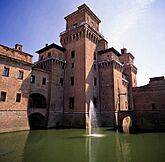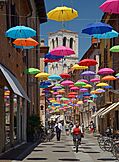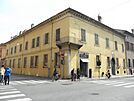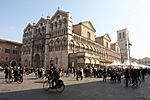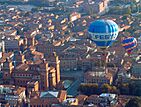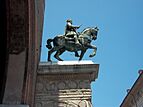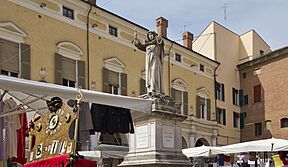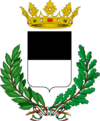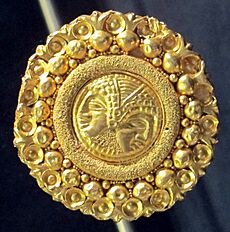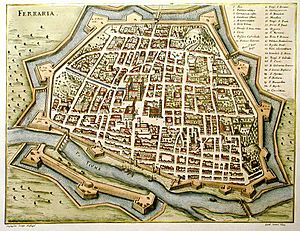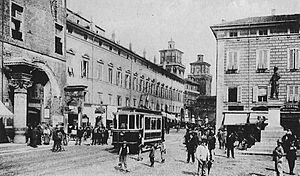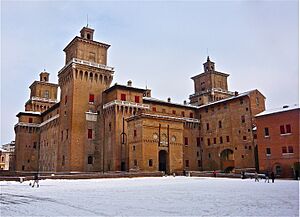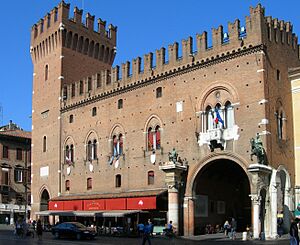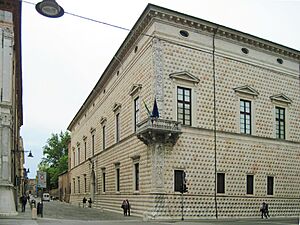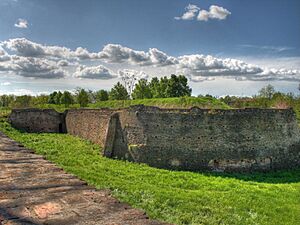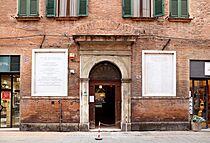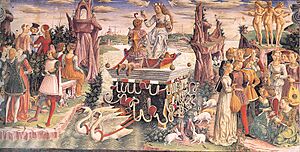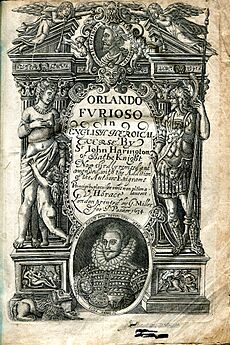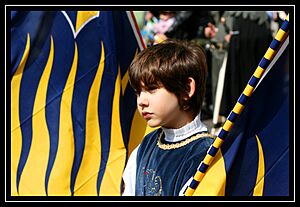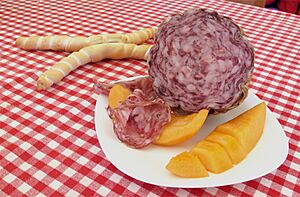Ferrara facts for kids
Quick facts for kids
Ferrara
Fràra (Emilian)
|
|||
|---|---|---|---|
| Comune di Ferrara | |||
|
From top left: The Castello Estense, Via Giuseppe Mazzini, Braghini-Rossetti Palace, San Giorgio di Ferrara Cathedral, aerial view of the city during its balloon festival, statue to Nicolò III d'Este in Palazzo Municipale, statue to Girolamo Savonarola in Piazza Savonarola.
|
|||
|
|||
| Country | Italy | ||
| Region | Emilia-Romagna | ||
| Province | Ferrara (FE) | ||
| Frazioni | Aguscello, Albarea, Baura, Boara, Borgo Scoline, Bova, Casaglia, Cassana, Castel Trivellino, Chiesuol del Fosso, Cocomaro di Cona, Cocomaro di Focomorto, Codrea, Cona, Contrapò, Corlo, Correggio, Denore, Focomorto, Francolino, Gaibana, Gaibanella, Sant'Egidio, Malborghetto di Boara, Malborghetto di Correggio, Marrara, Mezzavia, Monestirolo, Montalbano, Parasacco, Pescara, Pontegradella, Pontelagoscuro, Ponte Travagli, Porotto, Porporana, Quartesana, Ravalle, Sabbioni, San Bartolomeo in Bosco, San Martino, Spinazzino, Torre della Fossa, Uccellino, Viconovo, Villanova | ||
| Area | |||
| • Total | 404.36 km2 (156.12 sq mi) | ||
| Elevation | 9 m (30 ft) | ||
| Population
(31 December 2016)
|
|||
| • Total | 132,009 | ||
| • Density | 326.464/km2 (845.538/sq mi) | ||
| Time zone | UTC+1 (CET) | ||
| • Summer (DST) | UTC+2 (CEST) | ||
| Postal code |
44121 to 44124
|
||
| Dialing code | 0532 | ||
| Patron saint | St. George | ||
| Saint day | April 23 | ||
Ferrara is a beautiful city in Northern Italy. It is the capital of the province of Ferrara. As of 2016, about 132,000 people lived there.
The city is located northeast of Bologna, near the Po River. Ferrara is famous for its wide streets and many old palaces. These buildings date back to the Renaissance period. During that time, the powerful House of Este ruled the city. Because of its beauty and cultural importance, UNESCO has named Ferrara a World Heritage Site.
Contents
History of Ferrara
Ancient Times and Middle Ages
The first people lived in the Ferrara area around 600 BC. They were part of the Etruscan culture. An ancient Etruscan town called Spina was found nearby. Its ruins show that it was a very important place long ago.
Scholars are not sure if Ferrara started as a Roman town. Some clues suggest it might have begun as two small villages. These villages were built by the Byzantine Empire. They helped protect the area from invaders.
Ferrara is first mentioned in a document from 753 AD. A king named Desiderius captured the town. Later, the Franks gave Ferrara to the Papacy (the Pope's rule). In 988, the Church gave Ferrara to the House of Canossa.
By 1115, Ferrara became a free city, ruled by its own people. For a long time, two powerful families fought for control. Finally, the House of Este took over in 1264. Obizzo II d'Este became the ruler for life. This marked the start of the Este family's long rule. They governed Ferrara until 1598.
The Renaissance Era
The Este family made Ferrara a very important place. In 1452, Borso d'Este became a duke. Later, Ercole I became a duke in 1471. These rulers were great supporters of the arts. They helped Ferrara become a famous cultural center. It was known for its amazing buildings, music, books, and art.
A brilliant architect named Biagio Rossetti helped Ferrara grow. In 1484, Ercole I asked him to plan a new part of the city. This plan, called the "Erculean Addition," is a famous example of Renaissance city planning. It helped Ferrara become a UNESCO World Heritage Site.
Ferrara faced a tough war against Venice in 1482–84. Alfonso I became ruler in 1505. He married Lucrezia Borgia, a famous woman. Alfonso I was known for his strong army and excellent cannons.
In 1534, Ercole II became duke. His marriage to Renée of France made Ferrara even more respected. The city remained rich and a center for culture. However, a big earthquake hit in 1570. This caused the city's economy to suffer. When Ercole II's son, Alfonso II, died without children in 1597, the Este family lost control of Ferrara. The city then became part of the Papal States, ruled by the Pope.
Later History and Today
Ferrara was part of the Papal States for almost 300 years. During this time, the city slowly became less important. For a short time (1805–1814), it was part of Napoleon's Kingdom of Italy. After 1815, it went back to the Pope.
An Austrian army was stationed in Ferrara from 1832 to 1859. This was until Italy became one country. The old fortress built by the Pope was later taken down.
In the late 1800s and early 1900s, Ferrara was a trading center for farming goods. People worked hard to drain wetlands to create more farmland. This also helped get rid of malaria. Big factories came to Ferrara in the late 1930s.
During World War II, Ferrara was bombed. The bombs targeted railway lines and factories. After the war, a huge chemical factory was built. It made a lot of plastics for Italy. In recent years, Ferrara has focused more on tourism and services. Heavy industry is still there but is much smaller.
In May 2012, another earthquake hit Ferrara. It caused some damage to old buildings but no one was hurt.
Geography of Ferrara
Ferrara is located on the southern banks of the Po river. It is about 44 kilometers (27 miles) northeast of Bologna. The city is very flat, only about 9 meters (30 feet) above sea level. Being so close to Italy's largest river has always been important. Ferrara has had many floods, with the most recent one in 1951. The Idrovia Ferrarese is a waterway that connects the Po River from Ferrara to the Adriatic Sea.
Climate
Ferrara has a humid subtropical climate. This means it has mild winters and hot summers. It rains a lot in spring and autumn. Even in January, which is the driest month, there is still a good amount of rain.
| Climate data for Ferrara (Malborghetto di Boara) (1991–2020) | |||||||||||||
|---|---|---|---|---|---|---|---|---|---|---|---|---|---|
| Month | Jan | Feb | Mar | Apr | May | Jun | Jul | Aug | Sep | Oct | Nov | Dec | Year |
| Mean daily maximum °C (°F) | 6.9 (44.4) |
10.1 (50.2) |
15.3 (59.5) |
19.6 (67.3) |
24.3 (75.7) |
28.7 (83.7) |
30.9 (87.6) |
31.1 (88.0) |
26.0 (78.8) |
19.6 (67.3) |
12.7 (54.9) |
7.3 (45.1) |
19.4 (66.9) |
| Daily mean °C (°F) | 3.3 (37.9) |
5.2 (41.4) |
9.2 (48.6) |
13.2 (55.8) |
17.6 (63.7) |
21.9 (71.4) |
24.1 (75.4) |
24.4 (75.9) |
19.8 (67.6) |
14.8 (58.6) |
9.1 (48.4) |
4.0 (39.2) |
13.9 (57.0) |
| Mean daily minimum °C (°F) | −0.3 (31.5) |
0.1 (32.2) |
3.1 (37.6) |
6.7 (44.1) |
10.9 (51.6) |
15.0 (59.0) |
17.2 (63.0) |
17.5 (63.5) |
13.5 (56.3) |
9.8 (49.6) |
5.5 (41.9) |
0.7 (33.3) |
8.3 (47.0) |
| Average precipitation mm (inches) | 35.4 (1.39) |
43.7 (1.72) |
45.5 (1.79) |
53.6 (2.11) |
60.4 (2.38) |
59.4 (2.34) |
35.7 (1.41) |
40.5 (1.59) |
63.8 (2.51) |
73.8 (2.91) |
68.3 (2.69) |
44.2 (1.74) |
624.3 (24.58) |
| Source: Arpae Emilia-Romagna | |||||||||||||
Cityscape and Architecture
Famous Buildings
The impressive Este Castle is in the middle of Ferrara. It is a huge manor house with four strong towers and a moat. It was built in 1385 to protect the city and the Este family. The castle was updated many times in the 1400s and 1500s.

The Cathedral of Saint George was finished in 1135. It is a great example of Romanesque architecture. The cathedral has been changed many times over the centuries. So, it has a mix of Romanesque, Gothic, and Renaissance styles. The beautiful marble campanile (bell tower) was started in 1412. It was designed by Leon Battista Alberti but was never fully finished.
Near the cathedral and castle is the 15th-century city hall. This building was once where the Este family lived. It has a grand marble staircase and two old bronze statues.
The southern part of Ferrara is the oldest. It has many narrow streets from the Early Middle Ages. Casa Romei is one of the best-preserved medieval buildings. It was the home of a rich merchant. The house has beautiful fresco paintings inside.
Palazzo Schifanoia was built in 1385. It has frescoes showing the life of Borso d'Este. These paintings also show the zodiac signs and symbols for the months. The building also has old choir books and a collection of coins. The Renaissance Palazzo Paradiso is part of the Ferrara University library. It displays writings by famous authors like Torquato Tasso and Ludovico Ariosto.
The northern part of the city was added by Ercole I in the late 1400s. This area is called the Addizione Erculea. It has many Renaissance palaces. One of the most famous is Palazzo dei Diamanti ("Diamond Palace"). It gets its name from the diamond-shaped stones on its outside walls. This palace is home to the National Picture Gallery. It has a large collection of art from the "School of Ferrara." This art style became famous in the late 1400s.
Parks and Gardens
Ferrara is almost completely surrounded by 9 kilometers (5.6 miles) of old brick walls. Most of these walls were built between 1492 and 1520. Today, after being fixed up, the walls are a big city park. They are a popular place for people to run and bike.
People of Ferrara
| Historical population | ||
|---|---|---|
| Year | Pop. | ±% |
| 1861 | 64,204 | — |
| 1871 | 67,306 | +4.8% |
| 1881 | 70,442 | +4.7% |
| 1901 | 81,301 | +15.4% |
| 1911 | 95,721 | +17.7% |
| 1921 | 106,768 | +11.5% |
| 1931 | 115,628 | +8.3% |
| 1936 | 119,265 | +3.1% |
| 1951 | 133,949 | +12.3% |
| 1961 | 152,654 | +14.0% |
| 1971 | 154,066 | +0.9% |
| 1981 | 149,453 | −3.0% |
| 1991 | 138,015 | −7.7% |
| 2001 | 130,992 | −5.1% |
| 2011 | 132,545 | +1.2% |
| 2021 | 129,872 | −2.0% |
| Source: ISTAT | ||
In 2007, about 135,369 people lived in Ferrara. About 12% of the population were children and teenagers. The average age of people in Ferrara is 49. The city's population grew by 2.28% between 2002 and 2007. Ferrara is known as one of the oldest Italian cities with over 100,000 people. It also has a low birth rate.
Most people in Ferrara are Italian. There are also groups of people from other European countries, like Ukraine and Albania. The main religion is Roman Catholic. There is also a small but historic Jewish community.
Culture in Ferrara
Jewish Community
Ferrara has a Jewish community that has been there since the Middle Ages. It was very important when Ferrara was at its best in the 1400s and 1500s. This was during the time of Duke Ercole I d'Este. When the Este family moved away in 1598, the city came under the Pope's control. The Jewish area became a ghetto in 1627. This meant Jewish people had to live in a specific part of the city. The ghetto lasted until Italy became one country in 1859.
In 1799, the Jewish community helped save the city from being looted by soldiers. They paid a large sum of money to prevent the city from being damaged.
During World War II, Jewish people in Ferrara faced very difficult times. New laws were put in place that treated them unfairly. Many were sent away to camps, and only a few survived. The Italian Jewish writer, Giorgio Bassani, was from Ferrara. His famous book, The Garden of the Finzi-Continis, tells a story about a Jewish family in Ferrara during this time. It was later made into a movie.
In 2017, the first part of Italy's Museum of Italian Judaism and the Shoah opened in Ferrara. This museum will teach people about Jewish history and culture in Italy. It will also focus on the difficult period of the Shoah (Holocaust).
Visual Art
During the Renaissance, the Este family supported many artists. These artists, especially painters, formed the "School of Ferrara." Famous artists like Andrea Mantegna, Giovanni Bellini, Piero della Francesca, and Titian worked here. In the 1800s and 1900s, Ferrara continued to inspire painters. A large collection of these paintings can be seen in the National Gallery at Palazzo dei Diamanti.
Literature
Many famous writers and poets lived and worked in Ferrara during the 1400s and 1500s. These include Torquato Tasso, who wrote Jerusalem Delivered. Also, Ludovico Ariosto, known for his epic poem Orlando Furioso, and Matteo Maria Boiardo, who wrote Orlando Innamorato.
The Ferrara Bible was a special book published in 1553. It was a version of the Tanakh (Jewish Bible) in the Ladino language. In the 1900s, Ferrara was home to writer Giorgio Bassani. His novels were often turned into movies, like The Garden of the Finzi-Continis.
Religion

Ferrara was the birthplace of Girolamo Savonarola. He was a famous priest who became a leader in Florence in the late 1400s. He was known for speaking out against what he saw as wrong in society.
When Renée of France was Duchess of Ferrara, her court attracted many thinkers. These included people like John Calvin.
Music
The musician Girolamo Frescobaldi was born in Ferrara. He was a very important composer of keyboard music. His famous work, Fiori musicali, was published in 1635. It was studied by many composers, including Johann Sebastian Bach.
Cinema
Ferrara is the birthplace of Italian film directors Michelangelo Antonioni and Florestano Vancini. Vancini filmed his 1960 movie Long Night in 1943 in Ferrara. The city was also the setting for the famous 1970 movie The Garden of the Finzi-Continis. This film tells the story of a rich Jewish family during the time of Benito Mussolini and World War II. Other films have also been shot in Ferrara.
Festivals
The Palio of St. George is a medieval-themed horse race. It takes place every last Sunday in May. Started in 1279, it might be the oldest race of its kind in the world. The Ferrara Buskers Festival is a big event for street musicians. Artists from all over the world perform there. The city also hosts the yearly Ferrara Balloons Festival, a large hot-air balloon show.
Sport
Ferrara's football (soccer) team is called SPAL. It was started in 1907. In 2017, the team was promoted to Serie A, Italy's top football league. Their home stadium is Paolo Mazza Memorial Stadium.
Ferrara's basketball team, Kleb Basket Ferrara, plays in the Serie A2 Basket league. They play their home games at the Palasport di Ferrara.
Cuisine
Ferrara's food traditions go back to the Middle Ages. They sometimes show the influence of the city's Jewish community.
A special dish is cappellacci di zucca. These are ravioli filled with butternut squash, Parmesan cheese, and nutmeg. They are served with butter and sage sauce or bolognese sauce. Another unique dish is pasticcio di maccheroni. This is a macaroni pie with a sweet crust.
For Christmas, a traditional first course is cappelletti. These are large meat-filled ravioli served in chicken broth. After that, people often eat salama da sugo. This is a big, cured sausage made with pork and red wine.
Seafood is also important because Ferrara is near the Po delta and the Adriatic Sea. Pasta with clams and grilled eel dishes are well-known. Other popular foods include zia garlic salami and the traditional coppia bread. There is also a special kosher salami made from goose meat.
Local desserts include spicy pampepato chocolate pie and tenerina, a dark chocolate cake. Zuppa inglese is a pudding with chocolate and custard. The local soil is not great for wine, but there is a special wine called Bosco Eliceo.
International Relations
Twin Towns – Sister Cities
Ferrara is twinned with these cities:
 Broni, Italy
Broni, Italy Buenos Aires, Argentina
Buenos Aires, Argentina Formia, Italy
Formia, Italy Giessen, Germany
Giessen, Germany Highland Park, United States
Highland Park, United States Kallithea, Greece
Kallithea, Greece Kaufbeuren, Germany
Kaufbeuren, Germany Koper, Slovenia
Koper, Slovenia Krasnodar, Russia
Krasnodar, Russia Lleida, Spain
Lleida, Spain Prague 1, Czech Republic
Prague 1, Czech Republic Saint-Étienne, France
Saint-Étienne, France Sarajevo, Bosnia and Herzegovina
Sarajevo, Bosnia and Herzegovina Swansea, Wales, United Kingdom
Swansea, Wales, United Kingdom Szombathely, Hungary
Szombathely, Hungary
Images for kids
See also
 In Spanish: Ferrara para niños
In Spanish: Ferrara para niños


